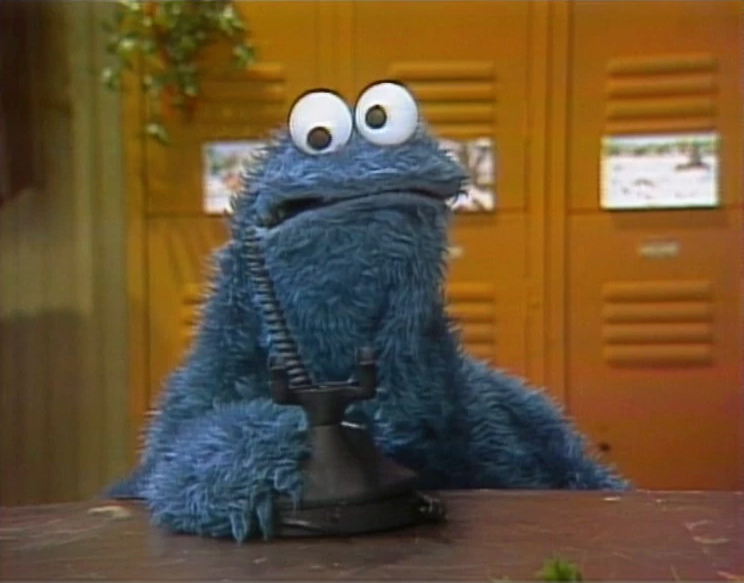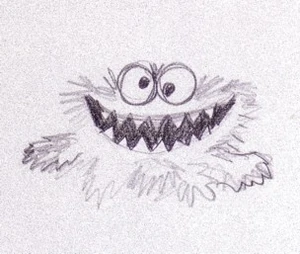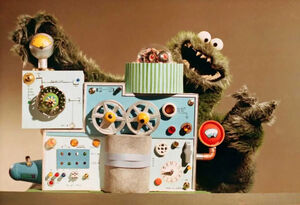Peteparker (talk | contribs) No edit summary |
|||
| Line 1: | Line 1: | ||
{{performer2|Frank Oz|1969 - present|David Rudman|2001 - present}} |
{{performer2|Frank Oz|1969 - present|David Rudman|2001 - present}} |
||
| − | [[Image:Cookie.jpg| |
+ | [[Image:Cookie-monster.jpg|right|thumb|300px|Good ol' Cookie]] |
[[Image:067.jpg|thumb|300px|"C Is For Cookie"]] |
[[Image:067.jpg|thumb|300px|"C Is For Cookie"]] |
||
| + | [[Image:Cookie.jpg|frame|Cookie Monster in ''[[Christmas Eve on Sesame Street]]'']] |
||
'''Cookie Monster''' is a voracious [[Muppet Monsters|monster]] and one of the main characters on ''[[Sesame Street]].'' Covered with blue fur and possessing a pair of googly eyes, Cookie Monster has an insatiable appetite. As his name implies, his primary craving is cookies, but he can (and often does) consume [[Items Other Than Cookies Consumed by Cookie Monster|anything and everything]], from apples and pie to [[Letters of the Alphabet|letters]], flatware, and hubcaps. Usually when he eats something, he makes loud munching noises, usually like "AWWWWM-num-num-num-num..." |
'''Cookie Monster''' is a voracious [[Muppet Monsters|monster]] and one of the main characters on ''[[Sesame Street]].'' Covered with blue fur and possessing a pair of googly eyes, Cookie Monster has an insatiable appetite. As his name implies, his primary craving is cookies, but he can (and often does) consume [[Items Other Than Cookies Consumed by Cookie Monster|anything and everything]], from apples and pie to [[Letters of the Alphabet|letters]], flatware, and hubcaps. Usually when he eats something, he makes loud munching noises, usually like "AWWWWM-num-num-num-num..." |
||
Revision as of 18:30, 8 May 2008
Template:Performer2
Good ol' Cookie
"C Is For Cookie"

Cookie Monster in Christmas Eve on Sesame Street
Cookie Monster is a voracious monster and one of the main characters on Sesame Street. Covered with blue fur and possessing a pair of googly eyes, Cookie Monster has an insatiable appetite. As his name implies, his primary craving is cookies, but he can (and often does) consume anything and everything, from apples and pie to letters, flatware, and hubcaps. Usually when he eats something, he makes loud munching noises, usually like "AWWWWM-num-num-num-num..."
Cookie Monster has a deep, growly voice, and generally speaks with a simplistic diction (e.g., "Me want cookie!"). He occasionally displays an unexpectedly complex vocabulary, however, and is at his most gentrified when in his Alistair Cookie persona, hosting Monsterpiece Theater.
He has been referred to and addressed variously as the Cookie Monster, Cookie Monster, or the affectionate diminutive Cookie. In a 2004 segment of Sesame Street, Cookie Monster revealed in song that before he started eating cookies (and became "Cookie Monster"), he was called Sid.
Origin

The Wheel Stealer (1966), sketch from Jim Henson's Designs and Doodles

The proto-Cookie Monster, from a 1967 IBM training film.
Jim Henson's Designs and Doodles explains Cookie Monster's early life: "In 1966, Henson drew three monsters who appeared in a General Foods commercial that featured three crunchy snack foods: Wheels, Crowns and Flutes. Each snack was represented by a different monster. The Wheel-Stealer was a short, fuzzy monster with wonky eyes and sharply pointed teeth. The Flute-Snatcher was a speed demon with a long, sharp nose and windblown hair. The Crown-Grabber was a hulk of a monster with a Boris Karloff accent and teeth that resembled giant knitting needles.
"These monsters had insatiable appetites for the snack foods they were named after. Each time the Muppet narrator, a human-looking fellow, fixes himself a tray of Wheels, Flutes and Crowns, they disappear before he can eat them. One by one, the monsters sneak in and zoom away with the snacks. Frustrated and peckish, the narrator warns viewers that these pesky monsters could be disguised as someone in your own home, at which point the monsters briefly turn into people and then dissolve back to monsters again."
As it turns out, these commercials were never aired—but all three monsters had a future in the Muppet cast. The Crown-Grabber was used in an Ed Sullivan Show sketch, in which he ruins a girl's beautiful day. Known from then on as the Beautiful Day Monster, he made a number of appearances on Sesame Street and The Muppet Show. The Flute-Snatcher turned into Snake Frackle, a background monster from The Great Santa Claus Switch and The Muppet Show.
And then there's the Wheel-Stealer, who was destined for greater things.
In 1967, Henson used the Wheel-Stealer puppet for an IBM training film called "The Coffee Break Machine." In the sketch, the monster (with pointed fangs) devoured a complex machine as the machine described its purpose and construction. His greed gets the better of him, however, as the machine's recording continues (within his stomach), announcing that it is wired to self-destruct. The monster promptly explodes. This sketch was also performed in October 1967 on The Ed Sullivan Show.
Two years later, Henson pulled the puppet out of the box again for three commercials selling Munchos, a Frito-Lay potato chip. This time, the puppet was called Arnold. After the three ads were produced, Henson had the opportunity to renew the contract. He chose not to, because at that point he was working on Sesame Street -- and that monster puppet was moving on to the next stage in his career.
Sesame Street
Proto-Cookie Monster, from Sesame Street: Episode 0043 (1969)
Kermit yells at proto-Cookie in a Season 1 sketch, as seen in The Sesame Street Book of People and Things.
In his early appearances on the show, Cookie Monster seemed somewhat scary to younger viewers, as he personified the childhood fear of "being eaten by a monster" -- which is somewhat ironic, since during the show's first season, he mostly played the role of a toddler who got in the way of everything without thinking, acted fussy when he didn't get his way, and was scolded by Kermit whenever he ate Kermit's property. However, this contradictory image did not last long, and Cookie Monster quickly became one of the most popular and beloved characters on the show. Cookie Monster's theme song, "C is for Cookie," is one of the most famous songs from Sesame Street.
In Sesame Street Magazine issue 144 (May 1985), CTW's associate research director Istar Schwager allayed the fears of some parents about Cookie Monster's bad habits: "Each of the characters on Sesame Street is designed to exaggerate a familiar human foible, and Cookie Monster is babyishness personified... When parents object to Cookie Monster's grammar, we remind them that children learn from a variety of sources -- including other Sesame Street characters who speak properly. Cookie's eating habits, too, are a point of concern for some parents. The inedible things that Cookie eats (a car fender!) make it clear to children that his behavior is out of the ordinary. Other characters, such as Captain Vegetable, of course, are vocal advocates of good eating habits."
Arlene Sherman recalled in a 1998 Museum of Television and Radio seminar; "We used to have a typist that corrected Cookie Monster's grammar!"
Since Sesame Street's format changes in the 2002-2003 season, Cookie Monster has hosted a regular segment called "Letter of the Day." In each episode he is presented with a cookie, upon which is written the letter of the day, in icing (and later, actual foam letters). Despite his best intentions, and various implausible schemes, he always succumbs to temptation.
To counter concerns that the character encourages poor eating habits, a number of "Healthy Habits for Life" segments and plotlines were introduced in Season 36, in which Cookie encourages viewers to eat a balanced diet, and enjoy cookies as a "sometimes food." However, the idea of Cookie Monster setting a good example for children with respect to their eating habits has been used since the 1970s, with public service announcements and individual sketches (most notably the rap spoof "Healthy Food").
However, the move toward highlighting healthy eating habits in 2005 led to a persistent rumor circulating in the media and on the internet that Cookie Monster would be dropped from the show, or renamed "Veggie Monster". Sesame Street poked fun at the media firestorm in a Season 37 episode. In a sketch in Episode 4115, Matt Lauer of The Today Show confronts Cookie Monster about the rumors that he's giving up cookies and becoming a "Fruit Monster". Cookie Monster refutes the rumor, explaining that he eats the fruit first, and then has cookies for dessert. Cookie Monster also says that the media is always blowing things out of proportion. (See Cookie Monster: A Cookie is a Sometime Food for more.)
Casting History
Main Performers
- Frank Oz - From 1969 to 2001 (occasional appearances to present)
- David Rudman - From 2001 to present
Alternate Performers
- Jim Henson - in The Ed Sullivan Show and commercials
- Joe Raposo (voice) - in "Everyone Likes Ice Cream"
- Caroll Spinney - in a 1969 sketch in which various monsters whisper the letter C.
- Eric Jacobson - occasionally in 2001[cite]
David Rudman officially became Cookie Monster's performer in Sesame Street's 2002 season (taped 2001), but the year before that, Rudman shared the part with Eric Jacobson. Once Jacobson was cast as Grover and Bert, Sesame Workshop chose Rudman as Cookie to allow for more interaction between Cookie and Bert/Grover.
Trivia
- Cookie Monster appears on episode 518 of The Muppet Show, and there's a gag about how he and guest Marty Feldman both have googly eyes.
- Cookie Monster's birthday is November 2nd.
- Very rarely did Cookie Monster actually "eat" real cookies on the set. He mostly gobbled on rice crackers, which were sometimes decorated to look like cookies.
- In the Ready To Learn parody of Mission: Impossible, Agent Cookie's entire body is shown.
- For the 2005/2006 season, Sesamstraat moved into new scenery. The scenery was introduced with a TV special. Bert, Ernie, Cookie Monster and Elmo flew over to Holland for this special occasion. It was the first time the American characters visited the Dutch street.
